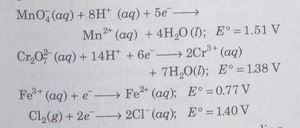Redox Titration
Step by step video solution for Redox Titration by Chemistry experts to help you in doubts & scoring excellent marks in Class 11 exams.
Updated on:21/07/2023Similar Questions
Knowledge Check
Standard electrode potential data are useful for understanding the suitability of an oxidant in redox titration some half cell reaction and their standard potentials are given identify the incorrect statement regarding the quantitative estimation of gaseous Fe(NO3)2
 AMnO−4can be used in aqueous HClBCr2O−27 can be used in aqueous HClCMnO−4 can be used in aqueous H2SO4DCr2O−27 can be used in aqueous H2SO4
AMnO−4can be used in aqueous HClBCr2O−27 can be used in aqueous HClCMnO−4 can be used in aqueous H2SO4DCr2O−27 can be used in aqueous H2SO4Standard electrode potential data are useful for understanding the suitability of an oxidant in redox titration some half cell reaction and their standard potentials are given identify the incorrect statement regarding the quantitative estimation of gaseous Fe(NO3)2
 AMnO−4can be used in aqueous HClBCr2O−27 can be used in aqueous HClCMnO−4 can be used in aqueous H2SO4DCr2O−27 can be used in aqueous H2SO4
AMnO−4can be used in aqueous HClBCr2O−27 can be used in aqueous HClCMnO−4 can be used in aqueous H2SO4DCr2O−27 can be used in aqueous H2SO4Statement The redox titarations in which liberated I2 is used as oxidant are called as idometric titration.
Explanation Addition of KI to CuSO4 liberates I2 which is estimated against hyposolution.AS is correct but E is wrong.BS is wrong but E is correct.CBoth S and E are correct and E is correct explanation of SDBoth S and E are correct but E is not correct explanation of S.
Redox reactions are of three types:
(i) Intermolernlar redox reactions.
(ii) lntramolecular redox reactions,
(iii) Auto redox reactions
OR
Disproportionation reactions.
Redox reactions are divided into two main types:
(i) Chemical redox reactions,
(ii) Electrochemical redox reactions which either produce or consume electricity
Oxidation and reduction process takes place in a reaction simultaneously.
Which of the following is a redox reaction?
View SolutionRedox reactions are of three types:
(i) Intermolernlar redox reactions.
(ii) lntramolecular redox reactions,
(iii) Auto redox reactions
OR
Disproportionation reactions.
Redox reactions are divided into two main types:
(i) Chemical redox reactions,
(ii) Electrochemical redox reactions which either produce or consume electricity
Oxidation and reduction process takes place in a reaction simultaneously.
Select the intramolccular redox reaction(s) among the following:
View SolutionRedox reactions are of three types:
(i) Intermolernlar redox reactions.
(ii) lntramolecular redox reactions,
(iii) Auto redox reactions
OR
Disproportionation reactions.
Redox reactions are divided into two main types:
(i) Chemical redox reactions,
(ii) Electrochemical redox reactions which either produce or consume electricity
Oxidation and reduction process takes place in a reaction simultaneously.
In which of the following reactions, H2O2, acts as reducing?
View SolutionRedox reactions are of three types:
(i) Intermolernlar redox reactions.
(ii) lntramolecular redox reactions,
(iii) Auto redox reactions
OR
Disproportionation reactions.
Redox reactions are divided into two main types:
(i) Chemical redox reactions,
(ii) Electrochemical redox reactions which either produce or consume electricity
Oxidation and reduction process takes place in a reaction simultaneously.
Which among the following acts as oxidising as well as reducing agent?
View SolutionRedox reactions are of three types:
(i) Intermolernlar redox reactions.
(ii) lntramolecular redox reactions,
(iii) Auto redox reactions
OR
Disproportionation reactions.
Redox reactions are divided into two main types:
(i) Chemical redox reactions,
(ii) Electrochemical redox reactions which either produce or consume electricity
Oxidation and reduction process takes place in a reaction simultaneously.
The value of x in the following reaction,
MnO4+8H++xe→Mn2++4H2O is
View Solution
